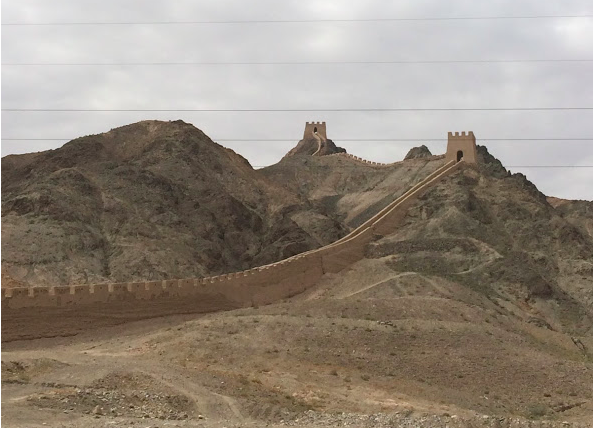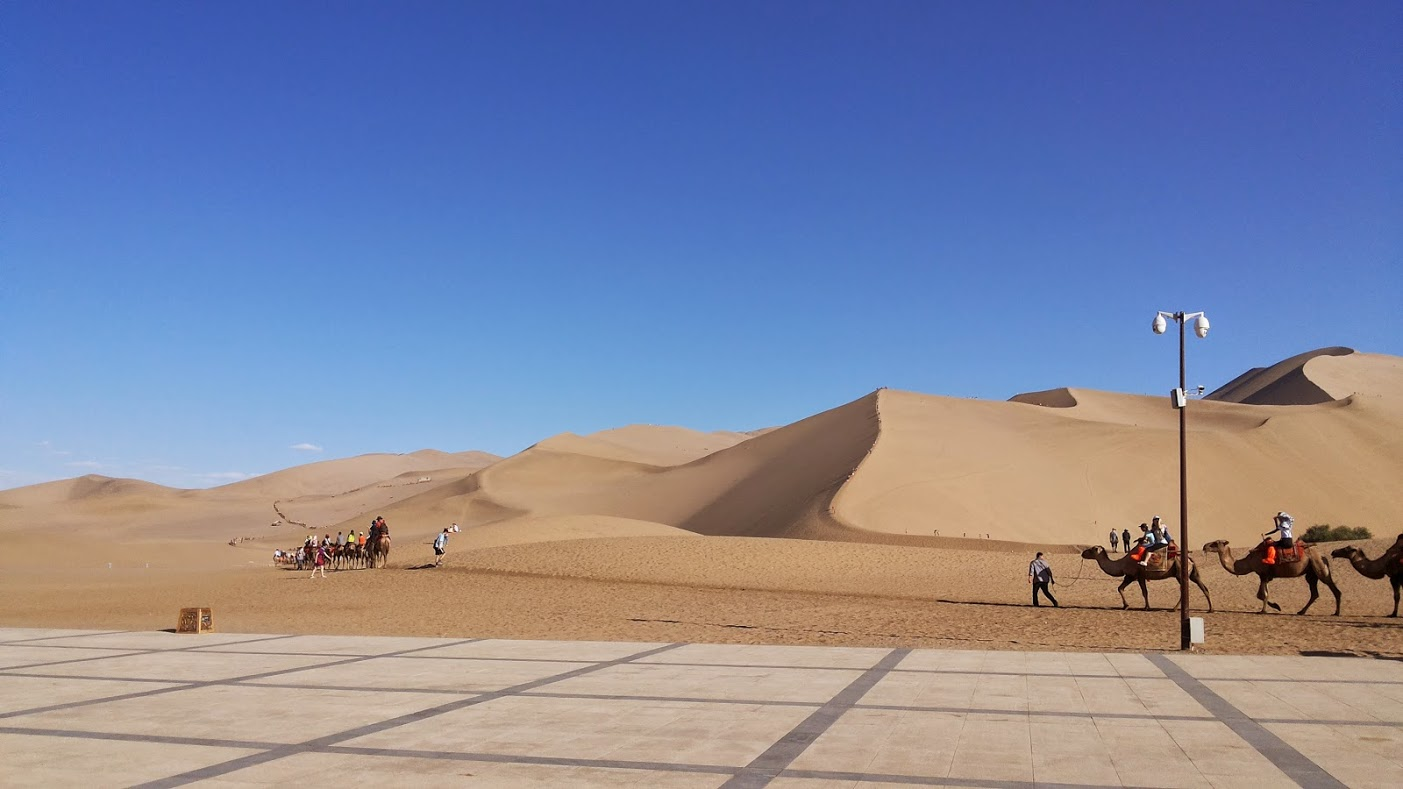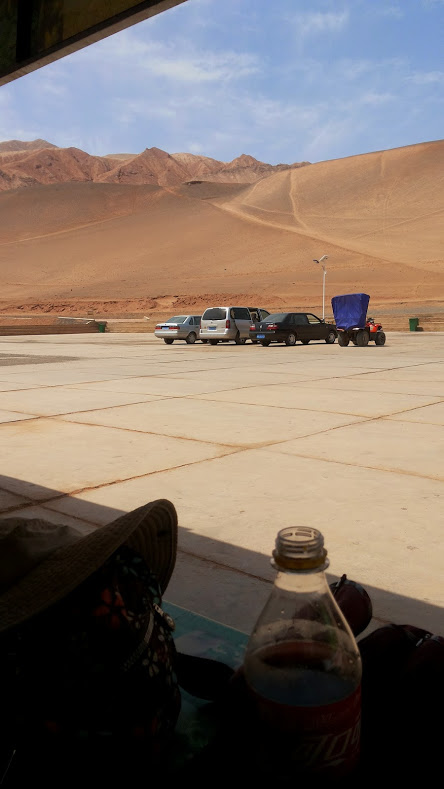Figure 1 - the area of north-west China where the events in this post took place in summer 2014, with the rough route we took shown in red.
The trip began with a gao tie, the name for China’s new network of high-speed trains, from Beijing to Xi’an. We skipped the Terracotta Warriors and headed straight to the highest rated roujiamo joint that my wife could find on dianping.com.

“OG” roujiamo, straight from the source. The lard was dripping down my arm.
Our first rental relocation assignment was to drive an oversized 4WD all the way to Jiayuguan, the western edge of the Great Wall. With a fuel-guzzling beast to satiate and Chinese road tolls to pay, it cost us just as much as flying would have, but at least we were able to stop over in Zhangye and check out the famous Danxia National Geopark.

On the road somewhere near Lanzhou.

Zhangye Danxia. Check it.

It was a long walk back from the bathroom.

Don’t visit Zhangye Danxia if you don’t like climbing steps.

The view from the top was worth it though.

After a minor setback caused by a power steering failure that required driving “the beast” very carefully through the back streets of Zhangye until we found the mechanic that our car rental company had nominated, we were speeding westward again in no time. In Jiayuguan we managed to visit the western end of The Wall and visit a local winery (unsurprisingly given the climate, they grow grapes out in that part of China) before it was time to change rental cars.

On the road again somewhere west of Zhangye.

A less-visited part of the Great Wall, Jiayuguan

The climate in north-west China is suited to grape production.

BBQ lamb’s brain, still in the skull, Jiayuguan (I think).
Fortuitously, we scored another rental relocation gig the very next day moving a much more manageable 4-seater about 400km west to Dunhuang, China’s famous desert oasis town. Our target was Urumqi, Xinjiang (and possibly beyond), but after a few days in Dunhuang and no sign of further gigs on the rental company website, we decided to skip the train and fly there (there were no fast trains that far west at the time).

On the main road into Dunhuang, northwest Gansu province.

View from our Dunhuang guesthouse parking lot.

These sand dunes are right on the edge of town. You can just park and walk into the desert.

Arty sunset pic.

This picture is a metaphor for something. Just not sure what.

Is that a mirage in the distance?

Alternatively, you can pay 20 bucks for the Chinese theme park version of the desert experience.

Which includes a camel ride.

Nan at “basecamp” preparing for her expedition.

Riding into the sunset.

Moonrise. I’ve always thought sunrises are overrated.

It’s not very often you see an oriental pagoda in the middle of a desert.
Once in Urumqi, my mother-in-law put us in contact with some distant relatives (of Chinese Han ethnicity), who naturally then arranged for an entire lamb to be butchered in our honour:

We ate every bit of this lamb. It took several days.

Best lamb skewers I’ve ever tasted.

Downtown Urumqi, where the Middle East meets The Orient.
Once the lamb was finished and we’d seen the sights (and tanks) of Urumqi, we took a quick trip down to Turpan, another oasis town which is famous for grapes, being really hot, and being near an area that is 150m below sea level.

Grapes literally growing in the street, Turpan.

Grape Alley, Turpan.

Rest stop on the highway between Turpan and Urumqi.

My favourite Xinjiang food, “kaobaozi” (baked lamb and onion buns)
After Turpan and some more time spent eating in Urumqi, we decided to head further west towards Khazakstan and hopefully, Kashgar. Still having no luck with the rental car relocations, we decided to take buses rather than fly again, so that we could “smell the roses”. This turned out to be a bad decision, as once you get out of Urumqi and Turpan, it’s very hard to find places that are allowed to host foreign guests in Xinjiang province. Despite the plethora of mid-range choices available to Chinese tourists, I had to settle for that one, overpriced government hotel in town. Travelling with a Chinese wife, this was frustrating for both of us, and after a few nights of this, we resorted to Nan booking the room and then sneaking me in later on.
After a few days of bus hopping through fairly unremarkable mid-size towns, we made it out to the Khazakstan border region, which was probably the highlight of the trip. There we stumbled upon the crystal clear (but freezing) Lake Sayram (in Chinese “Sailimuhu”), right beside the highway and still (in summer 2014) free to visit. We were so impressed that we decided to stay a few days in a Khazak homestay yurt. We hired a local driver and went in search of more “off the beaten path” Lake Sayrams, but alas, found that they had dried up long ago.

Lake Sayram, Xinjiang, near Yili.

I’d never seen water this clear in China before.

Putting on a brave face - the water was about 15 degrees!

Semi-wild horses in the hills near our yurt.

With our Uyghur driver - notice our eyes are the same colour!

Our home for two nights.

Lake views! This is probably a resort nowadays...


Chinese progress keeps marching westwards.

After a camel, how hard can a horse ride be?

Smelling the roses, metaphorically.
After two nights in a semi-permanent tent, we were ready for a hot shower and were glad to finally find a decent range of accommodation options in Ili (Yili), the capital of the Khazak autonomous prefecture. From there, it was a short bus ride to the nearest Khazakstan border post at Horgos, so we decided to set out on our next “curiosity mission”. The town itself was nothing to write home about, but it was interesting to see all the menus and shop signs in three languages (Uyghur, Chinese and Russian), and a sizeable minority of Caucasians going about their business in the streets. There was no way to get a Khazakstan visa at the border, but thankfully, the authorities had set up a special “border zone” experience that allowed Chinese citizens to cross the border on foot and buy Khazakstan products without exiting Chinese immigration. Once on the other side, we grabbed some lunch in a giant tent set up for Chinese tourists where they served up Soviet comfort food and mugs of Khazakstan beer. The waitress approached our table and spoke at me in Russian. We weren’t in Kansas anymore, Toto.

Snow-capped mountains in July! (somewhere in western Xinjiang - not near the border, but I just thought it was a cool photo).

This used to be the border between the USSR and China.

Donkeys and carts were still a thing in 2014 in Horgos.

All the menus were in Uyghur, Chinese and Russian. And English if you got lucky.

Standing on Khazakstan soil - 22nd July 2014

Looking back into China from Khazakstan.

The bread was a nice change from noodles.
After a few more days in Yili contemplating our options - another “off the beaten track” mission into the highlands to the east, or continuing further west towards Kashgar, we realised we didn’t really have time for either. My upcoming visa run to Australia was looming, and we needed to get back to Beijing. Kashgar would have to wait for another trip.
After one too many long bus rides, we told ourselves we’d go back to Xinjiang once they had a high-speed rail network. Funnily enough, the Lanzhou-Urumqi high-speed rail link opened later that year, and the Southern Xinjiang Railway from Turpan to Kashgar has since been upgraded to make travel times tolerable. Maybe, once I’m able to get back into China, it’s time for another trip out west.






















